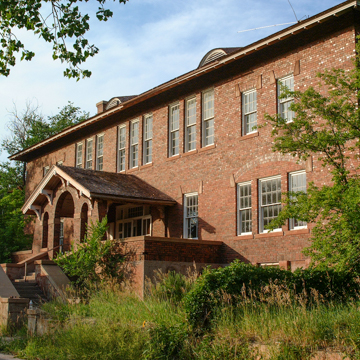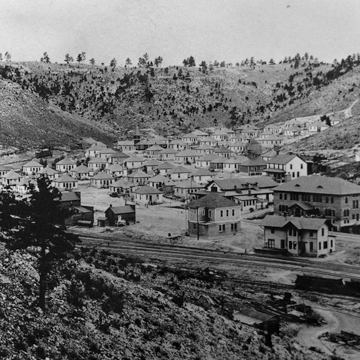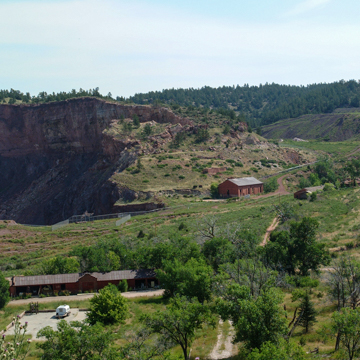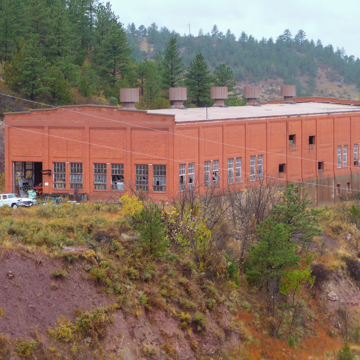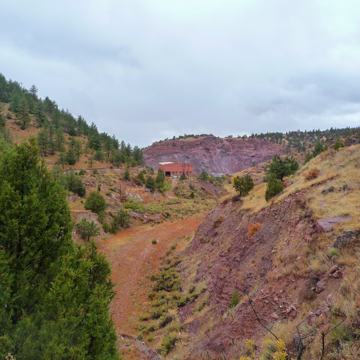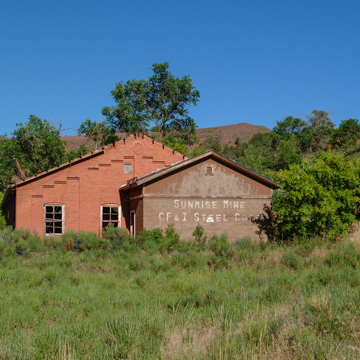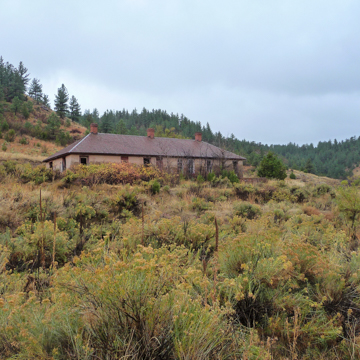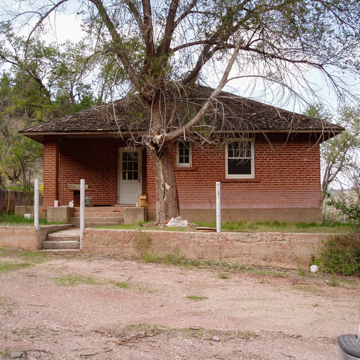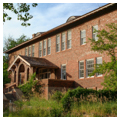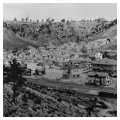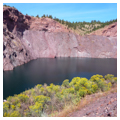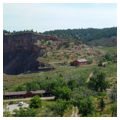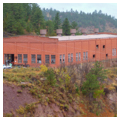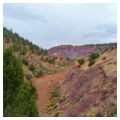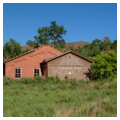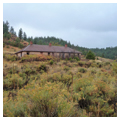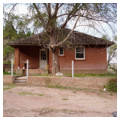You are here
Sunrise Mine
From 1898 to 1980, Sunrise was an iron ore mine and company town operated by the Colorado Fuel and Iron Company (CF&I) in the high desert foothills of eastern Wyoming. Today, the site is a privately owned, 225-acre National Register Historic District, containing thirty-nine buildings, structures, foundations, and landscape features representing eighty years of iron-ore mining. The site is surrounded by canyon walls on three sides. Red dust from the red ochre that accompanies the iron and copper deposits scattered throughout the area colors everything in the site, including the trees and buildings.
Archaeological research has revealed that as early as 12,000 years ago, Native Americans were extracting the red ochre found in the Sunrise site for body painting, and were using stones from the area for the production of tools. The site seems to have served this purpose until the Late Prehistoric Period. Early Euro-American settlers and soldiers from nearby Fort Laramie started mining small quantities of copper and iron here in the mid-to-late 1870s.
Iron-ore mining was always the most significant mining activity, when Sunrise Mine served as the principal source of iron used at the CF&I plant in Pueblo, Colorado. During an 80-year period, mine buildings were constructed and updated, new shafts were sunk, electrical power replaced steam power, and mining techniques evolved from simply stripping blasted waste material from ore with a rail-mounted steam shovel, to sophisticated underground mining. In fact, several new engineering techniques were pioneered at Sunrise, including the glory-hole and block-cave methods of mining. Many thousands of tons of Sunrise ore were shipped by rail 375 miles south to Pueblo, where the ore was smelted and used to make railroad rails, fencing wire, and other important products used in the development of the West.
Sunrise was also well known in Wyoming and among the CF&I facilities as a model company town. The townsite was clean and tidy, and after 1917 boasted the first YMCA in the state. People came from neighboring towns to view movies and participate in bowling tournaments at the Sunrise Y.
The Sunrise property is roughly divided into three sections: the mining area, the railroad and maintenance yard, and the company town. The mining area’s main feature is the 44-acre, 650-foot-deep mining pit known as the Glory Hole, where thousands of tons of ore were extracted. The 1904 boiler house represents the earliest, steam-powered mining era, while a large brick hoist house (1944) represents Sunrise’s role in producing iron for World War II, when CF&I constructed a 199-foot-tall headframe, the highest steel headframe in the U.S. at that time. The company’s effort to compete with international markets after the war is evident in the remains of a 1964 beneficiation plant, used to further refine the ore before shipping. The interior of the shower house (1906) is still stained red from the dirt of generations of miners who went straight to the shower after emerging from underground, and the 1917 laboratory still contains hand-written records of ore samples. In the hillsides surrounding the site are several cave-like storage areas for explosives. Three to four million yards of tailings are stacked up at the northeast edge of the industrial area.
In the railroad and maintenance yard, original railroad grades and a few railroad ties mark the location of a line built to haul ore out of Sunrise and bring building and living supplies into the town, in addition to providing passenger rail service for residents. An engine house dating from 1963 was used for on-site repair of trains and other mining equipment.
The townsite, extending along Highway 318 west of the railroad yard, contains the ruins of an infirmary, a brick duplex, and the centerpiece of the town—the Italian Renaissance Revival-style YMCA. The two-story, brick building features bowling lanes in the basement (one is intact, complete with its manual pin setter), rooms designated for socializing, playing cards, reading, and sewing on the main floor. On the upper floor is a combination auditorium/movie theater/gymnasium with a stage, wooden movie screen, and projection room. The stately hip-roofed building has a symmetrical facade generously lit with large, multi-light, double-hung windows in triple, paired, and single configurations. Concrete staircases from both the east and west converge on a landing from which a single staircase continues up to the arched front porch. Decorative details on the building include battered porch walls with arched openings, bracketed eaves and gable ends, double doors with sidelights and transom and first floor windows arranged in a Palladian motif. Two louvered eyebrow dormers accent both the front and rear slopes of the roof. A ghost sign reading “Sunrise Mine, CF&I Corp.” appears on the front stair wall.
At the eastern edge of the town site, canyon walls were terraced to accommodate a compact residential area, laid out in a grid pattern, with streets running east-west and north-south, alleys, sidewalks, and concrete gutters. The terraces are built of stacked rock. Individual yards are marked by borders of concrete into which iron poles were inserted, and fences strung between the poles. Five brick houses are the sole remaining buildings representing several blocks of single-family housing. There are a number of terraced walls, roads, foundations, stairs, clothesline poles, iron fence poles, and remnants of individual yards and gardens that help visitors interpret the town site.
The Sunrise Mine site is fascinating for its mining and social history, including the development of different mining techniques and the efforts made to design a company town where workers would be satisfied and thus, the company believed, productive. Anxious to avoid some of the mistakes made in its company towns in Colorado, CF&I sent William Porter, an engineer from its Denver office, to lay out the town in 1900, and the company provided commercial and recreational facilities for residents in addition to small, four-room homes. Over the years, and especially after the infamous Ludlow Massacre in Colorado in 1914, CF&I built brick houses and garages, a hospital, water and sewage systems, two schools, a hotel, a train depot, a gas station, a church, a YMCA, and other facilities, in order to maintain a steady source of local labor, foster a sense of community, and ensure labor relations did not deteriorate. Many considered Sunrise a model company town, and the YMCA and its amenities were unrivaled in the state.
By the 1950s, as commuting became the norm, the population of the town of Sunrise gradually declined. As people moved out, the company destroyed the houses. Meanwhile, in spite of expensive improvements to mining facilities made in the 1960s, iron ore mining in the U.S. could not complete with foreign ore, and labor strikes at other CF&I facilities caused slowdowns at Sunrise. When CF&I closed down Sunrise mining operations in 1980, the company salvaged most of the mining equipment, and destroyed all but five of the remaining houses.
References
Humstone, Mary and Dwayne Meadows, “Sunrise Mine Historic District,” Platte County, Wyoming. National Register of Historic Places Registration Form, 2005. National Park Service, U.S. Department of the Interior, Washington, DC.
Writing Credits
If SAH Archipedia has been useful to you, please consider supporting it.
SAH Archipedia tells the story of the United States through its buildings, landscapes, and cities. This freely available resource empowers the public with authoritative knowledge that deepens their understanding and appreciation of the built environment. But the Society of Architectural Historians, which created SAH Archipedia with University of Virginia Press, needs your support to maintain the high-caliber research, writing, photography, cartography, editing, design, and programming that make SAH Archipedia a trusted online resource available to all who value the history of place, heritage tourism, and learning.

